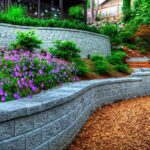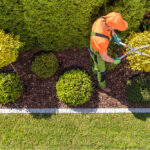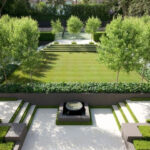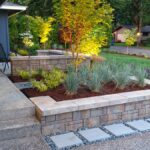How To Use Mulch
How important is adding mulch to residential and commercial landscapes? Possibly more important than you think! Mulching your trees, shrubs, and borders is one of the best things you can do to improve both the appearance and the long-term health of your property.
Here, we’ll tell you all about the benefits of landscape mulch, including:
- What mulch is (and is not!)
- How mulch benefits your landscape when it’s used correctly
- What kind of mulch to choose
- How to apply mulch – and what to avoid
- How much mulch to use (and how to calculate the right amount)
Mulch – What It Is and Is Not
Mulch is very simply a layer of material placed on top of the soil to cover bare ground.
There are many choices when it comes to buying mulch. But not all types of mulch are created equal. Some will enrich your landscape, others are mostly decorative, and some can even be harmful. It can be composed of a wide variety of things, including:
- organic materials (like wood, bark, leaves, pine needles, coco hulls, compost, or grass clippings),
- inorganic materials (such as gravel, river rocks, or glass pebbles), or
- synthetic substances (including rubber, plastic, and landscape fabric).
Mulch is not incorporated into the soil or used to directly amend it (like, for example, compost). Instead, it’s used as a top-dressing.
To get the most benefits from landscape mulch, we recommend using organic mulch.
Common Types of Organic Mulch
Wood Chip Mulch
This type of organic mulch is made from a variety of tree species and includes ground-up wood, bark, twigs, and (often) leaves. It’s also readily available and reasonably priced.
Because of its mixed makeup, this type of much has:
- a good range of naturally slow-decomposing compounds, such as lignin and cellulose from wood and tannins and suberin from bark
- faster decomposing material from leaves.
This means short- and long-term nutrient availability for your plants, and longer-lasting surface volume.
Bark Chip or Shredded Bark Mulch
Mulch made from chipped or shredded bark contains only bark, no wood or other organic materials. The bark is usually redwood, Douglas fir, or cedar.
Depending on its style or type, the bark is often one single species graded by chip size, giving it a uniform appearance. However, it has less water holding capacity (bark is naturally water-resistant) and fewer types of wood compounds to enrich your soil when compared to wood chip mulch.
This type of mulch is generally more expensive than wood chips.
Dyed Mulch / Pallet Mulch
Most mulch that is colored red, brown, or black is made from recycled wood pallets. The dyes used are not toxic and they make the appearance of the mulch more uniform, which some people prefer. Pallet mulch is made from long-dried wood, which easily absorbs the colored dyes. This aged dryness also slows down the mulch’s decomposition rate.
However, colored pallet mulch may also contain other processed materials such as particleboard, pressure-treated wood, and other construction and demolition waste. Some pallet mulches have been found to contain creosote and the arsenic-based preservatives that were long used to make pressure-treated wood.
While these toxic preservatives are no longer used in manufacture, construction waste that has wood from old decks, retaining walls, and other construction may contain the preservatives and carry them into the resulting mulch.
If you prefer the appearance of colored mulch, look for mulch made from dyed bark (instead of recycled wood products) and with a clear indication of where it was sourced from.
How To Use Mulch And The Benefits of Mulch in Your Landscape
Mulch acts much like a blanket when spread over your planted beds. It protects the soil and the roots of plants and trees. When you add mulch to your planted beds, you create a permeable barrier that:
- Regulates soil temperature – Whether outdoor temperatures reach sweltering or are below freezing, mulch can prevent large swings in soil temperature. This keeps plant roots healthy and reduces the occurrence of frost heaving.
- Slows down water evaporation – When less moisture evaporates from the soil, it lowers your irrigation needs.
- Enriches soil as it breaks down – Decomposed organic mulch provides long-term improvement to soil structure and fertility (this doesn’t apply to inorganic mulches).
- Smothers and slows weed growth – Mulch covers weed seeds that land on the soil’s surface and blocks the sunlight they need to sprout, meaning fewer weeds and less work for you.
- Makes planted beds look clean, tidy, and well cared for – Need we say more?
How Much Mulch to Use
Whichever type of mulch you choose, apply (and replenish) a layer that’s thick enough to provide you with all its benefits.
Mulch isn’t a surface coating, like a layer of paint. While a thin layer of raked mulch will look nice when it’s first applied, it won’t provide the major benefits you need in the long term. That’s why a thick (but not too thick!) layer of mulch is required.
Apply mulch to a minimum thickness of three inches. Four inches is better and is what we usually recommended. The thick “fluffiness” of newly applied mulch is reduced as the mulch absorbs rainfall, shifts and settles into place, and gets walked on.
Remember, it’s this very thickness that provides many of mulch’s benefits.
What to Avoid When Using Mulch
The number one thing to avoid when using organic wood mulch is the mulch volcano.
Mulch volcanoes are what happen when mulch is piled up against the trunk of a tree or shrub and forms a volcano-shaped collar around it. While you may see other homeowners or landscape contractors doing this, you’ll never see Green Grounds Landscaping, LLC. creating a mulch volcano.
Instead, our landscape professionals in Minnesota always keep mulch away from the trunks of trees and shrubs by tapering the layer’s depth down to zero as it approaches the trunk flare or stem base.
Why? Because mulch volcanoes can be fatal to trees and landscape plants!
Organic wood mulch retains moisture, which is helpful in keeping the soil moist. Plus, moisture and microbes both work to break down of the mulch into humus and humic acid in the soil.
But when this moisture-retaining mulch is piled up against the base of a tree or woody shrub, it can invite the kind of unwanted bacteria and fungal growth that can penetrate the bark and kill the plant from the inside.
So, use plenty of mulch to cover your soil, but keep it from resting against growing plants.
How To Use Mulch to Prevent Erosion
Water doesn’t just evaporate from soil, it falls on it in the form of rain. But heavy and regular rainfall on bare soil can cause problems that a layer of mulch will prevent.
Sudden strong rainstorms that hit bare soil can create rivulets and erode soil faster than you might think. And rain droplets can also compact the surface of bare soil and create a hard crust, making the soil unable to absorb water and creating more runoff. Once these have occurred, it takes more time and more effort to reverse the damage to your soil. A thick layer of mulch is well worth it given that it can prevent these problems from happening.
Naturally occurring rains can also become part of destructive stormwater events, which we all need to work together to prevent. Small measures, like keeping soil surfaces protected and porous, go a long way toward helping absorb and slow rainfall runoff and should be part of any stormwater management efforts in Minnesota.
Calculating How Much Mulch to Buy
Whether you buy mulch in bags or in bulk, you’ll need to calculate how much you need for the areas you’re mulching.
Mulch is measured by volume (cubic feet). To calculate the cubic feet of mulch you need for your landscape, multiply the square footage of your planting areas by the depth of mulch you want (as a fraction – divide the number of inches by 12 to get the right number).
How We Can Help
Whether you have many small planting areas to mulch, need mulch spread around landscape trees, or want to cover a large area of bare soil, we can help with your mulching needs in Minnesota
We’ll calculate the right amount of mulch you need to adequately protect your landscape and deliver it in large-volume trucks. This ensures that the “recipe ” for the mulch will be the same so its appearance will be uniform across all your landscape areas. Our landscape crews will spread it evenly and to the right depth, leaving your landscape looking its best.
We always recommend adding regular mulching to your list of seasonal maintenance tasks, and we’re sure that you’ll be pleased with the ways hard-working mulch improves your landscape.









